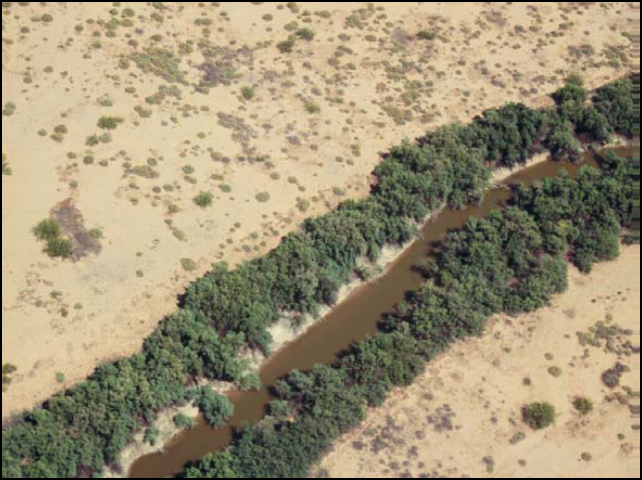Killing saltcedar does not increase streamflow in the Pecos River

Saltcedar, an introduced species choking many Texas waterways, has long been a prime suspect in dwindling streamflows, but a Texas A&M AgriLife team has found that Tamarix, the plant in question, may have been falsely accused of that specific crime.
Dr. Alyson McDonald, Texas A&M AgriLife Extension Service range specialist at Fort Stockton, said saltcedar was probably introduced into the U.S. as an ornamental shrub and windbreak plant in the early 1800s. The tree, any of several species originally from Eurasia, can reach heights of 25 feet or more and form very think stands. It has been very successful here and is often the predominant tree species found along many Texas waterways.
Because it is so prevalent, since at least the 1940s there have been multiple saltcedar control projects implemented along rivers throughout the Southwestern U.S. in an effort to increase streamflow. One early unsubstantiated report indicated a mature saltcedar used around 200 gallons of water per day, although this volume has since been refuted by Texas A&M AgriLife Research scientists, McDonald said.
"It seems only logical that killing saltcedar would increase streamflow," she said. "Trouble is, none of those projects resulted in a measured, documented increase in flow.
"Why? It defies logic. Turns out that on the Pecos River where our study took place, and probably along other rivers where the trees are large and mature and the riparian zone relatively narrow that saltcedar water use is an insignificant component of the water budget.
"So before spending taxpayer dollars to kill saltcedar for the sole purpose of increasing streamflow, it would be prudent to measure saltcedar water use. Evaporation from the river channel is about 9.5 feet per year, which is substantially greater than the amount transpired by saltcedar."
McDonald was the lead author on the study, "Tamarix Transpiration Along a Semiarid River has Negligible Impact on Water Resources," published in Water Resources Research.
McDonald's team included Dr. Bradford Wilcox and Dr. Georgianne Moore, department of ecosystem science and management, Texas A&M University, College Station; Dr. Charles Hart, Dow AgroSciences, Stephenville; Dr. Zhuping Sheng, AgriLife Research, El Paso; and Dr. Keith Owens, department of natural resource ecology and management, Oklahoma State University, Stillwater.
The study, with funding from the U.S. Department of Agriculture Cooperative State Research, Education and Extension Service and the U.S. Environmental Protection Agency, was conducted near Mentone on the Pecos River, where large stretches of saltcedar were killed with herbicide but no increases in streamflow resulted.
"We were baffled why increases in streamflow weren't seen following saltcedar removal," McDonald said. "Were there actually no water savings or are those savings just too hard to detect on a large scale?"
The team measured sap flow to determine water use in saltcedar trees growing along the banks of the Pecos River and also evaluated stream stage and groundwater levels in monitoring wells within the saltcedar stand to find the answers. She said a previous study at the same location attributed groundwater fluctuations to saltcedar water use.
"If these fluctuations are indeed caused by saltcedar, then groundwater levels should decline as saltcedar water use peaks during the day," she said. "Similarly, if saltcedar reduces streamflow, then the effect should be evident in the stream stage. We detected a weak response in only one of the monitoring wells, and no response in the stream stage.
"Saltcedar trees along the Pecos River were large and mature but had little sapwood area per acre. Thus, sap flow or water use also was relatively low compared to young, actively growing, multi-stemmed saltcedar growing along the Rio Grande at a site in New Mexico also evaluated by Dr. Moore," she said.
McDonald added that the riparian zone along the Pecos River in Texas is narrow, so the result of the combination of these two factors is that saltcedar water use is a relatively small component of the water budget.
"In other words, if saltcedar transpiration is not closely coupled to streamflow, control of saltcedar is not likely to have any influence on streamflow," she said.
However, McDonald noted their findings do provide a framework for evaluating the potential for salvaging water or increasing streamflow through riparian vegetation management.
"First, that framework includes determining the transpiration rate of target plants, which is dependent on environmental conditions, plant growth stage and plant species. Second, a comparison of transpiration rates versus streamflow will indicate whether or not it is possible to detect a change in streamflow resulting from reduced transpiration.
"So bottom line, brush control is unlikely to yield water if transpiration is a small component of the water budget. And the ratio of transpiration to streamflow will affect the impact of brush control on water yields."
More information: "Tamarix transpiration along a semiarid river has negligible impact on water resources." Water Resources Research. DOI: 10.1002/2014WR016866
Journal information: Water Resources Research
Provided by Texas A&M University
















